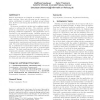225 search results - page 7 / 45 » From sequential programs to concurrent threads |
TACAS
2009
Springer
14 years 2 months ago
2009
Springer
Abstract. We propose a static analysis framework for concurrent programs based on reduction of thread interleavings using sound invariants on the top of partial order techniques. S...
TACAS
2010
Springer
13 years 5 months ago
2010
Springer
The choice of where a thread scheduling algorithm preempts one thread in order to execute another is essential to reveal concurrency errors such as atomicity violations, livelocks,...
POPL
2009
ACM
14 years 2 months ago
2009
ACM
Speculative execution is an important technique that has historically been used to extract concurrency from sequential programs. While techniques to support speculation work well ...
CHI
2009
ACM
14 years 8 months ago
2009
ACM
Multitasking in user behavior can be represented along a continuum in terms of the time spent on one task before switching to another. In this paper, we present a theory of behavi...
POPL
2005
ACM
14 years 8 months ago
2005
ACM
Modern applications are designed in multiple tiers to separate concerns. Since each tier may run at a separate location, middleware is required to mediate access between tiers. Ho...

